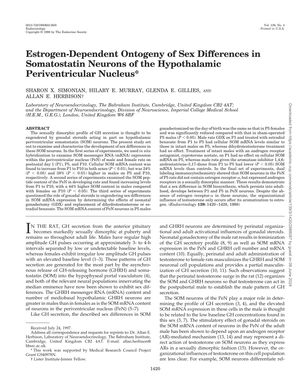Estrogen-Dependent Development of Sex Differences in Somatostatin Neurons of the Hypothalamic Periventricular Nucleus
March 1998
in “
Endocrinology
”

TLDR Male rats have more somatostatin neurons than females due to testosterone converting to estrogen during early development.
The study investigated the development of sex differences in somatostatin (SOM) neurons in the hypothalamic periventricular nucleus (PeN) of rats, focusing on the role of gonadal steroids. It was found that SOM mRNA and peptide content increased from postnatal day 1 (P1) to P10 in both male and female rats, with males showing significantly higher levels at P5 and P10. Neonatal gonadectomy (GDX) on P1 reduced SOM mRNA content in males to levels similar to females, indicating the influence of gonadal steroids. Treatment with estradiol benzoate, but not dihydrotestosterone, restored SOM mRNA levels in GDX males, suggesting that testosterone's effect on SOM biosynthesis requires its conversion to estrogen. Androgen receptors were present in a sexually dimorphic pattern in SOM neurons, despite the absence of estrogen receptor-alpha. The study concluded that sex differences in SOM biosynthesis in PeN neurons, which persist into adulthood, are established between P1 and P5 and are dependent on the conversion of testosterone to estrogen.


